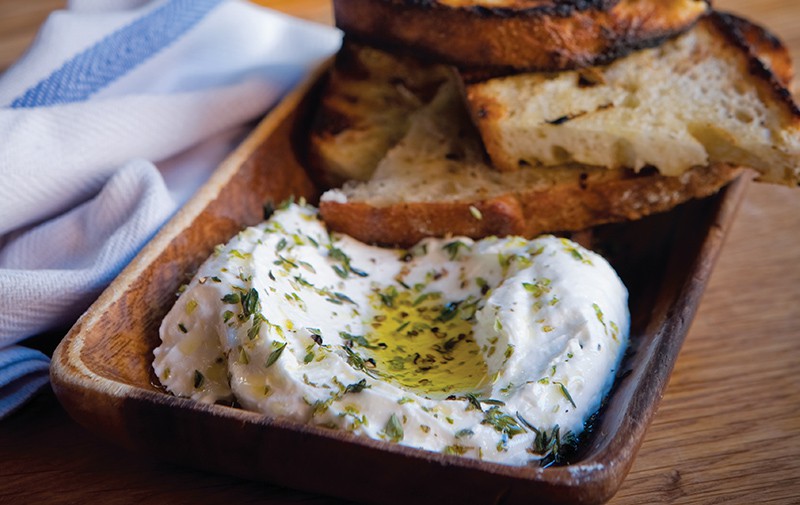
“No, really, you have to have the ricotta.” I knew the guy urging me on had impeccable taste, yet I couldn’t imagine why I should order a bland, boring plate of ricotta at Locanda Verde, a New York restaurant renowned for great cooking. A cheese made from cheesemaking leftovers? (Ricotta means “recooked.”) I’d use it to enrich a bowl of pasta or fill a crisp cannoli shell, sure, but make a course of it solo? Why bother?
Because—as it turned out—this Sardinian import consisted of cumulous clouds of creamy curds that tasted of pure milk, warm sheep, and herby grass. It needed nothing more than a sprinkle of salt and a drizzle of olive oil; even the deep toastiness of the bread served with it was a little distracting.
My local cheesemonger doesn’t fly in ricotta from Italy, but he does carry Salvatore Ricotta. Made in Brooklyn with whole cow’s milk from the Hudson Valley, it is richer than its Sardinian cousin and doesn’t have the same sheepy tang, but it is incredibly delicious in its own lactic way. It needs no fussing: just pile it in a bowl, top with a generous glug of olive oil, and sprinkle with sea salt. With crusty bread on the side, it doesn’t even require a fork.
What makes it a meal—for me, at any rate—is a glass of wine. And there comes the challenge. What to drink with such a delicate cheese? What can cut through ricotta’s richness and play off its lactic tang, yet let the cheese’s pure milky goodness sing? (It’s worth noting, by the way, that this same wine pairing puzzler comes for fresh mozzarella and burrata.)
At Locanda Verde, I was too dazzled by the cheese to think about wine, so I e-mailed Joshua Nadel, Locanda’s sommelier, to ask him what he likes to drink with the ricotta. “Whites with a bit more texture, such as the Ronchi di Cialla Ribolla Gialla from the north, or Cantina del Taburno Coda di Volpe from the south, go well,” he replied. “The lean and mean steely, citric-style whites don’t offend, but those with a touch more flesh and broader flavor do a bit better.”
I put his theory to test, thinking that in fact a lean, grassy sauvignon blanc could be just the thing to play up the springlike freshness of the cheese. It wasn’t. Not that it was bad, but the pairing was a little like a playdate between two-year-olds, well behaved yet entirely self-absorbed. The Coda di Volpe, on the other hand, has plenty of personality (coda di volpe means “tail of the wolf,” hinting at the wine’s rather woolly flavor) and an almost beeswax richness; it melded into the ricotta, creating one wild, succulent mouthful, neither light nor heavy, and redolent of warm milk, honey, and thyme.
Nadel also suggested some reds—those so light that they behave almost like white wines, with subtle flavors, little astringency, and bright acidity. “Valle dell’Acate Cerasuolo di Vittoria has enough acid and tannin to cut through,” he wrote. Lacking a Cerasuolo, I pulled out a rosé made from Lagrein, a northern Italian grape with soft tannins and a bewitching violet aroma and blackberry flavor. The effect was entirely different: it made the ricotta feel meatier, more substantial, in part because toasted bread became more central in the equation. This bodes well for cooler, hungrier evenings.
Over at Lunetta, the Brooklyn restaurant where sous chef Betsy Devine hatched the Salvatore Ricotta brand with her partner Rachel Mark, chef/owner Adam Shepard concedes that few wines on his wine list are going to wreck the cheese, but his first choice would be the Palagetto Vernaccia, a white from Tuscany. “It’s so aromatic, it comes out of the glass like a bouquet,” he says, adding that the variety’s typically bitter edge is well tempered by the cheese’s sweet milkiness. For Shepard, dynamic whites, ones with lots of texture and personality, are the way to go.
I mention that one of my favorite summer-day pairings is ricotta with a just off-dry, lightly bubbly Prosecco; Shepard meets me halfway. “Well,” he says, “a Moscato d’Asti—it’s light and not too sweet, with tiny bubbles—a small splash of that with the sweet and herby cheese can be really fun.”
Now summer dinner and dessert are solved.
THE LIST
Italian wines are highlighted here, but there’s no reason you can’t stray to other origins. In general, what you want to pair with ricotta (and, for that matter, other super fresh milky cheeses like mozzarella and burrata) is a white wine with substance and personality, but without a lot of excess sweetness or oak. Bubbles work well, too, as long as there is a little sweetness; a very dry sparkler will feel stark next to the rich, smooth cheese. And very light reds can be delicious with a little chill, particularly if you want to round out your cheese dinner with some grilled vegetables. Below are some suggestions to get you started.
SPARKLING
- Adriano Adami Prosecco Brut Garbèl 13 ($16)
- Canella Prosecco Brut ($16)
- Sorelle Bronca Prosecco di Valdobbiadene Extra Dry ($18)
WHITE
- Palagetto Vernaccia di San Gimignano ($14)
- Ribolla Gialla ($18)
- Ronchi di Cialla Colli Orientali del Friuli Cantina del Taburno Amineo Coda di Volpe ($17)
ROSÉ/RED
- Grosjean Frères Valle d’Aosta Torrette ($23)
- Muri-Gries Alto Adige Lagrein Rosato ($17)
- Valle dell’Acate Cerasuolo di Vittoria ($21)
SWEET
- Fontanafredda Moscato d’Asti Moncucco ($12/375ml)
- Paolo Saracco Moscato d’Asti ($15)
- Vietti Moscato d’Asti Cascinetta ($14)




